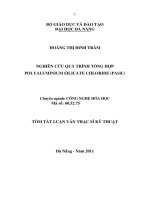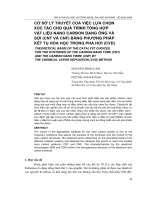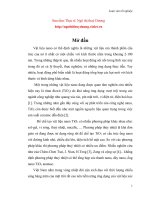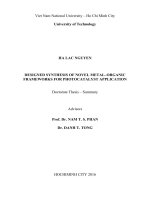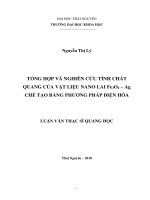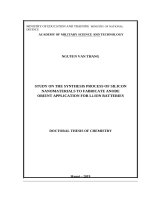Luận văn nghiên cứu quá trình tổng hợp vật liệu nano silic để chế tạo anode định hướng ứng dụng cho ắc quy li ion
Bạn đang xem bản rút gọn của tài liệu. Xem và tải ngay bản đầy đủ của tài liệu tại đây (2.89 MB, 134 trang )
MINISTRY OF EDUCATION AND TRAINING MINISTRY OF NATIONAL DEFENCE
ACADEMY OF MILITARY SCIENCE AND TECHNOLOGY
NGUYEN VAN THANG
STUDY ON THE SYNTHESIS PROCESS OF
SILICON NANOMATERIALS TO FABRICATE ANODE
ORIENT APPLICATION FOR Li-ION BATTERIES
DOCTORAL THESIS OF CHEMISTRY
Hanoi – 2019
MINISTRY OF EDUCATION AND TRAINING MINISTRY OF NATIONAL DEFENCE
ACADEMY OF MILITARY SCIENCE AND TECHNOLOGY
NGUYEN VAN THANG
STUDY ON THE SYNTHESIS PROCESS OF
SILICON NANOMATERIALS TO FABRICATE ANODE
ORIENT APPLICATION FOR Li-ION BATTERIES
Specialization: Theoretical chemistry and Physical chemistry
Code: 9 44 01 19
DOCTORAL THESIS OF CHEMISTRY
Scientific supervisors:
Dr. Nguyen Tran Hung
Assoc. Prof. Dr. Nguyen Manh Tuong
Hanoi – 2019
i
STATEMENT OF AUTHORSHIP
I assure that the thesis is my own research work. The data and results presented in
the dissertation are honest and have not been unpublished in other work. The
reference is fully cited.
Hanoi, date:
Ph.D student
Nguyen Van Thang
ii
ACKNOWLEDGMENTS
First of all, I would like to express their deep gratitude to my supervisors Dr.
Nguyen Tran Hung and Assoc. Prof. Dr. Nguyen Manh Tuong for their direct
instruction guidance and support throughout my thesis implementation process.
I am grateful for the help of the Training Department, Academy of Military
Science and Technology throughout the complete process of the thesis.
I sincerely express my deepest thanks to the head of the Institute of Materials Chemistry, the head of the Nanomaterials Department, the colleagues and my
friends for their encouragement.
Ph.D student
Nguyen Van Thang
iii
TABLE OF CONTENTS
Page
LIST OF FIGURES ...............................................................................................................vi
LIST OF TABLES ..................................................................................................................x
LIST OF SYMBOLS AND ABBREVIATIONS ..............................................................xi
INTRODUCTION ..................................................................................................................1
CHAPTER 1: OVERVIEW...................................................................................................5
1.1. Overview of LIB ..............................................................................................................5
1.1.1. The new generation of electrochemical sources ........................................................5
1.1.2. LIB..................................................................................................................................7
1.1.3. Domestic and foreign research situation on LIB .....................................................13
1.2. Anode materials of LIB .................................................................................................15
1.2.1. Ion storage material ....................................................................................................15
1.2.2. Anode graphene ..........................................................................................................17
1.2.3. Anode from silicon material, silicon nanoparticles/graphene ................................19
1.3. Methods of synthesis silicon nanoparticles and current progress of thermodynamics,
the kinetics of synthesis of silicon nanoparticles from rice husk. ...........................................21
1.3.1. Overview of silicon.....................................................................................................21
1.3.2. Introduction about rice husk and current status of rice husk use in our country ........26
1.3.3. The synthesis nano Si from rice husk .......................................................................27
1.4. Synthesis methods of graphene ....................................................................................29
1.4.1. Overview of graphene .................................................................................. 29
1.4.2. Synthesis methods of graphene .................................................................... 31
1.5. Kinetics and thermodynamics.......................................................................................35
1.5.1. Kinetic conditions .......................................................................................................35
1.5.2. Thermal analysis and reaction kinetics study by thermal analysis.........................36
1.5.3. Thermodynamic conditions .......................................................................................39
CHAPTER 2: SUBJECTS AND METHODS OF RESEARCH ....................................41
2.1. Research subjects ...........................................................................................................41
2.2. Research Methods ..........................................................................................................41
iv
2.2.1. The synthesis method of nano Si from rice husk .....................................................41
2.2.2. Kinetic, thermodynamic characteristics of synthesis nano Si from rice husk.......45
2.2.3. Synthesis of rGO from graphite ................................................................................46
2.3. Synthesis of nano Si@rGO material for LIB's anode ................................................47
2.4. Fabrication of LIB to test electrochemical properties of anode materials ................48
2.4.1. The fabrication process of LIB’s anode....................................................................48
2.4.2. LIB fabrication process ..............................................................................................49
2.5. Methods of studying the composition and material structure ....................................50
2.5.1. Scanning electron microscope (SEM) method ........................................................50
2.5.2. Energy-dispersive X-ray spectroscopy (EDX) method ..........................................51
2.5.3. Transmission electron microscopy (TEM) method.................................................51
2.5.4. Fourier-transform infrared spectroscopy method (FT-IR)......................................51
2.5.5. X-ray diffraction method (XRD)...............................................................................52
2.5.6. Isothermal method adsorbed gas nitrogen ................................................................52
2.6. Methods of surveying electrochemical properties of electrodes ...............................52
2.6.1. Cyclic voltammetry (CV)...........................................................................................52
2.6.2. Galvanostatic charge-discharge (GC) .......................................................................55
CHAPTER 3: RESULTS AND DISCUSSION ................................................................57
3.1. Synthesis silica nanoparticles from rice husk ..............................................................57
3.1.1. Investigate the effects of acid treatment ...................................................................57
3.1.2. Investigate the effects of calcination mode .................................................. 61
3.1.3. Thermodynamics, the kinetics of the process of synthesis silica nanoparticles
from rice husk ........................................................................................................................67
3.2. Synthesis of silicon nanoparticles from silica nanoparticles......................................72
3.2.1. Investigation of factors affecting silicon nanoparticles synthesis process ............72
3.2.2. Kinetics of the process of synthesis silicon nanoparticles from silica nanoparticles ..77
3.3. Synthesis nano rGO and nano Si@rGO ......................................................................79
3.3.1. Synthesis nano rGO ....................................................................................................79
3.3.2. Investigate the structure and composition of nano Si@rGO materials .................89
3.4. Application of rGO, nano Si and nano Si@rGO materials for fabrication LIB’s anode. 92
v
3.4.1. Experimental fabrication anode material combination ...........................................92
3.4.2. The electrochemical characteristics of LIB ..............................................................94
3.5. Conclusion of chapter 3 .............................................................................................. 105
CONCLUSION .................................................................................................................. 107
LIST OF PUBLICATIONS RELATING TO THESIS .......................................... 109
LIST OF REFERENCES .................................................................................................. 110
vi
LIST OF FIGURES
Pages
Figure 1.1. Comparison of energy densities and specific energy of different
rechargeable batteries. .............................................................................................. 5
Figure 1.2. Some Li-ion batteries on the white background. ................................... 6
Figure 1.3. Schematic of the electrochemical process in LIB ................................. 7
Figure 1.4. Structures of common cathode materials: ........................................... 10
Figure 1.5. The model illustrates the formation of host-guest compound .......................16
Figure 1.6. Schematic picture of the failure mechanism of silicon nanoparticles during
cycling. ...................................................................................................................................20
Figure 1.7. Schematic process for fabricating the silicon nanoparticles/graphene
nanocomposite. ......................................................................................................................21
Figure 1.8. Schematic of silicon synthesis silicon nanoparticles by chemical vapor
deposition of silanes ..............................................................................................................24
Figure 1.9. Schematic of silicon synthesis by electrochemical etching method .............25
Figure 1.10. Graphene is the basic structure of other carbon nanostructures ........ 30
Figure 1.11. The bonds of carbon atoms in the graphene. ................................................30
Figure 1.12. Image illustrating graphene oxide film ..........................................................33
Figure 1.13. The thermal reducing reaction of hydroxyl groups ........................... 34
Figure 1.14. The thermal reducing reaction of carbonyl groups ............................ 34
Figure 2.1. Process of synthesizing silica nanoparticles from rice husk. .........................43
Figure 2.2. Process of synthesizing silicon nano from silica nano ...................................44
Figure 2.3. Schematic diagram of the reduction facility for silicon nanoparticles
synthesis process .................................................................................................... 44
Figure 2.4. rGO synthesis process from graphite. ..............................................................46
Figure 2.5. The thermal reduction process of GO in the furnace. ......................... 47
Figure 2.6. The synthesis process of nano Si@rGO. .........................................................48
Figure 2.7. The fabrication process of LIB’s anode...........................................................49
Figure 2.8. LIB with the two-electrode structure and glove box. .....................................50
Figure 2.9. Cyclic voltammetry waveform. ........................................................................53
vii
Figure 2.10. LIB with the two-electrode structure to measure electrochemical
characterizations ..................................................................................................................54
Figure 3.1. TG/DTA curve of rice husk at the heating rate of 3 oC/min ..........................57
Figure 3.2. SiO2 content in rice husk ash dependence on acid treatment time. ...............58
Figure 3.3. SiO2 content in rice husk ash dependence on acid treatment temperature ...59
Figure 3.4. SiO2 content in rice husk ash dependence on ratio rice husk/HCl acid. .......60
Figure 3.5. Influence of calcination temperature on SiO2 content in rice husk ash. .......62
Figure 3.6. Influence of calcination time on SiO2 content in rice husk ash. ....................62
Figure 3.7. SEM images of rice husk ash samples after calcination at the temperature of
650 oC at the heating rates of 3, 6, 9, 12, 15 oC/min, respective. ......................................63
Figure 3.8. SEM and EDX images of nano SiO2. ..............................................................64
Figure 3.9. Particle size distribution of nano SiO2. ............................................................65
Figure 3.10. XRD pattern of nano SiO2. .............................................................................65
Figure 3.11. SEM image of nano SiO2 sample in high-resolution. ..................................66
Figure 3.12: TEM image of nano SiO2. ..............................................................................66
Figure 3.13. DSC curves of rice husk pyrolysis process with heating rates of 3, 6,
9, 12, 15 oC/min. .................................................................................................... 67
Figure 3.14. Plots of lg and 1/Tp of RHs of the F-W-O model ......................................68
Figure 3.15. Plots of ln(β/Tp2) and 1/Tp of RHs of the Kissinger model..........................68
Figure 3.16. DTA curves of rice husk pyrolysis process with heating rates of 3, 6,
9, 12, 15 oC/min ..................................................................................................... 69
Figure 3.17. Plots of lg and 1/Tp of RHs of the F-W-O model. ........................... 70
Figure 3.18. Plots of ln(β/Tp2) and 1/Tp of RHs of the Kissinger model. .............. 70
Figure 3.19. Si content dependence on mol ratio Mg/SiO2................................................72
Figure 3.20. Si content dependence on calcination temperature. ......................................73
Figure 3.21. SEM images of nano Si samples obtained by magnesiothermic reduction
of nano SiO2 with heating rates of 5 °C/min and 15 °C/min. ...........................................74
Figure 3.22. N2 adsorption-desorption isotherms and the pore size distribution of
nano Si RH-5 ........................................................................................................................75
viii
Figure 3.23. DSC curves of the reaction between nano SiO2 and Mg with different
ramp rates. ..............................................................................................................................75
Figure 3.24. XRD pattern of nano Si RH-5. .......................................................................76
Figure 3.25. Particle size distribution of nano Si RH-5. ....................................................76
Figure 3.26. TEM image of nano Si RH-5. ............................................................ 77
Figure 3.27. DSC curves of nano SiO2 reduction process with Mg with heating rates of
5, 9, 12, 15 oC/min .................................................................................................................77
Figure 3.28. Plots of lg and 1/Tp in the reduction of SiO2 by Mg of the F-W-O model ....... 78
Figure 3.29. Plots of ln(β/Tp2) and 1/Tp in the reduction of SiO2 by Mg of
Kissinger model ...................................................................................................................78
Figure 3.30. GO gel after acid washing...............................................................................79
Figure 3.31. GO gel after freeze-drying. .............................................................................79
Figure 3.32. Graphite particle size distribution. .................................................................80
Figure 3.33. GO particle size distribution. ..........................................................................80
Figure 3.34. FT-IR spectra of graphite. ...............................................................................81
Figure 3.35. FT-IR spectra of GO........................................................................................81
Figure 3.36. TG/DTA curve of GO at the heating rate of 10 oC/min...............................83
Figure 3.37. XRD pattern of graphite. ................................................................... 83
Figure 3.38. XRD pattern of GO. ........................................................................................84
Figure 3.39. SEM image of graphite. ..................................................................................84
Figure 3.40. SEM image of GO. ............................................................................ 85
Figure 3.41. TEM image of GO. ............................................................................ 85
Figure 3.43. Image of rGO sheets. .......................................................................................86
Figure 3.44. rGO powder......................................................................................................86
Figure 3.45. FTIR spectra of rGO........................................................................................87
Figure 3.46. TG/DTA curve of GO at the heating rate of 10 oC/min...............................87
Figure 3.47. SEM images of rGO at different resolutions. ...............................................88
Figure 3.48. XRD pattern of rGO. .......................................................................................88
Figure 3.49. EDX pattern of rGO (M1.1). ..........................................................................89
Figure 3.50. EDX pattern of rGO (M2.1). .........................................................................89
ix
Figure 3.51. EDX pattern of nano composite
Figure 3.52. XRD pattern of nano composite Si@rGO. ...................................................90
Figure 3.53. SEM, TEM images of nano composite Si@rGO. ............................. 91
Figure 3.54: Schematic for synthesis process of nano composite Si@rGO. ...................91
Figure 3.55. Compound slurry of nano composite Si@rGO/cacbon/PVDF + NMP. .........92
Figure 3.56. LIB’s anode with a 11 mm diameter. ................................................ 92
Figure 3.57. Material structure of anode/cacbon/PVDF. ....................................... 93
Figure 3.58: SEM image and EDX pattern of carbon superP...........................................93
Figure 3.59. SEM image of the anode/cacbon/PVDF material. ............................ 94
Figure 3.60. Cyclic voltammetry curves of LIB with anode fabricated on rGO basis of
the first two cycles at a scan rate of 0.1 mV/s in the voltage range of 0.0-2.0 V. ......... 95
Figure 3.61. Cycling performance of LIB with anode fabricated on rGO basis under the
current rate 0.1C (37.2 mA/g) in the voltage range of 0.0-2.0 V, 100 cycles. .................. 96
Figure 3.62. The rate capability of LIB with anode fabricated on rGO basis at the
current rates from 37.2 mA/g to 18.600 A/g, 110 cycles. ...................................... 96
Figure 3.63. Cyclic voltammetry curves of LIB with anode fabricated on nano Si basis
of the first two cycles at a scan rate of 0.1 mV/s in the voltage range of 0.0-2.0 V...... 98
Figure 3.64. Galvanostatic discharge-charge profiles of LIB with anode fabricated
on nano Si basis at the current rate of 0.05C in the voltage range of 0.0-1.5 V. ... 99
Figure 3.65. Cycling performance of LIB with anode fabricated on nano Si basis under
the current rate 0.1C in the voltage range of 0.0-2.5 V, 35 cycles. .................................. 99
Figure 3.66. Cyclic voltammetry curves of LIB with anode fabricated on nano Si@rGO
basis of the first two cycles at a scan rate of 0.1 mV/s in the voltage range of 0.0-2.0 V. 101
Figure 3.67. Galvanostatic discharge-charge profiles of LIB with anode fabricated on
nano Si@rGO basis at the current rate of 0.05C in the voltage range of 0.0-2.5 V. ... 102
Figure 3.68. Cycling performance of LIB with anode fabricated on nano Si@rGO basis
under the current rate 1.5C in the voltage range of 0.0-2.5 V, 500 cycles...................... 102
Figure 3.69. The rate capability of LIB with anode fabricated on Si@rGO basis at
the different current rates in the voltage range of 0.0-2.5 V, 50 cycles. ................... 104
x
LIST OF TABLES
Pages
Table 1.1. Characteristics of cathode materials. ...................................................... 9
Table 1.2. Advantages and disadvantages of LIB ..............................................................13
Table 1.3. Characteristics of cathode materials ..................................................... 16
Table 1.4. Properties of graphene .......................................................................... 31
Table 2.1. Typical analysis of rice husk ................................................................. 42
Table 2.2. Typical analysis of Mg powder............................................................. 42
Table 2.3. Samples of materials after grinding in the process of synthesis rGO ... 47
Table 2.4. Properties of copper foil .....................................................................................48
Table 2.5. Properties of lithium foil .....................................................................................49
Table 3.1. SiO2 content in rice husk ash dependence on ...................................................61
Table 3.2. Basic kinematic parameters according to the FWO model and Kissinger
model in rice husk pyrolysis process. ..................................................................................68
Table 3.3. Basic kinetic parameters according to the FWO model and Kissinger model
in rice husk pyrolysis process. ..............................................................................................70
Table 3.4. Thermodynamic parameters of the synthesis of silica nanoparticles from
rice husk .................................................................................................................................71
Table 3.5. Si content dependence on molar ratio Mg/SiO2. ...............................................72
Table 3.6. Basic kinetic parameters according to the FWO model and Kissinger model
in the reduction of SiO2 by Mg. ...........................................................................................78
Table 3.7. The electrochemical characteristics of LIB with anode fabricated on
rGO, nano Si and nano Si@rGO basis and previous publications. ...................... 104
xi
LIST OF SYMBOLS AND ABBREVIATIONS
Ah
Ampere-hour
Anode
An electrode of the battery
C
Capacity
Cathode
An electrode of the battery
CE
Counter Electrode
CMC
Carboxymethyl cellulose
CNF
Carbon nanofiber
CNT
Carbon nanotube
CV
Cyclic voltammetry
CVD
Chemical Vapor Deposition
DMC
Dimethyl carbonate
DoD
Depth of discharge
DSC
Differential scanning calorimetry
DTA
Differential Thermal Analysis
e
Electron
EC
Ethylen cacbonate
EDX/EDS Energy–dispersive X-ray spectroscopy
EMC
Ethyl methyl carbonate
FE-SEM
Field Emission Scanning Electron Microscopy
FT-IR
Fourier transform infrared spectroscopy
FWO
Flynn-Wall-Ozawa model
GC
Galvanostatic Cycling
GO
Graphene oxide
LIB
Li-ion battery
Li-ion
Lithium ion
MA
Methyl acetate
xii
mAh
Milliampere-hour
mAh/g
Milliampere-hour/gram
MCMB
MesoCarbon MicroBeads
NiCd
Nickel cadmium
NiMH
Nickel metal hydride
NMP
N-methylpyrrolidinone
PC
Propylene cacbonate
PDDA
Poly (diallyl dimethyl ammonium)
PTC
Positive thermal coefficient
PTFE
Poly (tetrafluoroethylene)
PVA
Poly (vinyl alcohol)
PVDF
Poly (vinylidene fluoride)
Wh/kg
Watt-hour/kilogram
Wh/l
Watt-hour/litre
R
Resistance
RE
Reference Electrode
rGO
Reduced Graphene Oxide
SEI
Solid Electrolyte Interphase
SEM
Scanning Electron Microscopy
TGA
Thermal Gravicmetric Analysis
SUP-P
Super-P, Carbon black
WE
Working Electrode
XRD
X-ray Diffraction
1
INTRODUCTION
1. The urgency of the thesis topic
The phenomenon of global warming, energy shortage worldwide, the increasing of
pollution in cities are serious challenges that promote the replacement of fossil fuels
that cannot be renewed by green energy sources such as solar energy, wind energy
and nuclear energy,...Compared to the traditional fossil fuels, most green energy
sources often depend on the geographical location of each region, weather and
season, so that the energy conversion devices cannot be operated continuously, the
efficiency is not high. For nuclear energy, there are many potential risks of radiation
damage to human health and the environment. Therefore, the demand for energy
storage is essential. On the other hand, outbreaks of emissions such as CO, CO2 and
the air pollution consequences can be reduced by replacing the internal combustion
engines in electric motors or gasoline-electric hybrid vehicles. Therefore, the energy
storage issue for these devices has become more important than ever.
Strategic energy planners have paid attention to renewable energy sources that are
considered endless such as sun, wind, tide but these types of energy are often
discontinuous or unable to develop this kind of energy in some areas. Therefore, to
use these energy sources effectively, you must store them in the form of electricity
with devices such as batteries or capacitors. Besides, the rapid development of
information technology and electronics has enriched the life with many genres of
the audiovisual media, the communication devices, homemaker equipment, portable
medical devices, even the artificial parts that can be implanted in the body, the
alarms, the occupational safety,... and entertainment electronic toys with
increasingly functions as automatic, remote control, meeting the outdoor
conditions,... All these devices use batteries as power supplies. On the artificial
satellites and spacecraft, although the equipment and machinery are far away from
humans, they work normally and give accurate results thanks to the chemical power
stored from the solar energy. In order to ensure the equipment is working properly,
it is necessary to have suitable energy sources, a large capacity, high efficiency,
reusable and especially compact and safe. In addition, this device must be cheap,
2
non-toxic. This is the goal in the research of making rechargeable batteries,
especially solid batteries [9].
Since Li-ion batteries (LIB) appeared, scientists have recognized this is an advanced
battery generation with its many advantages such as high specific energy density, a
rather compact size, number of charge-discharge cycles more (about 400 - 600
times) [1, 2, 9]. LIB's anode materials are one of the issues of great concern.
Currently, graphite materials are widely used because they are cheap and easy to
manufacture but have low capacity, only in the range of 130 - 270 mAh/g in
practical operation [2]. The main requirement of current anode materials improves
the working capacity, the durability and to increase the number of charge-discharge
cycles. In materials that can be used for the LIB’s anode, silicon is potential
material thanks to its very high specific capacity (up to 4200 mAh/g), respectively
Li22Si5 compound [2, 97, 99]. However, the reaction of Si with Li+ can cause
material cracking with a volume increase of about 400 %, it will reduce the capacity
of the electrode as well as the capacity and reducing the durability of the electrode
[101]. In order to minimize its structural changes due to the silicon cracking, many
studies in the world have been done as synthetic silicon materials in the form of
nanofibres, nanoparticles with a porous structure,... In our country, this research
direction has been new, there is no research on synthetic technology as well as
surveying the electrochemical characteristics of the LIB with anode on the silicon
nanoparticles basis.
In agricultural by-products in Vietnam, although the rice husk has a large output, it
hardly used effectively. In the rice husk, SiO2 content accounts for a large
proportion (over 20% by mass). This is the natural amount of SiO2, if it is processed
and used effectively, this will be an abundant source of materials for synthesizing
silicon nano. However, the research on this process is currently not concerned.
Therefore, “Study on synthesis process of silicon nanomaterials to fabricate
anode orient application for Li-ion batteries” has a lot of scientific and practical
significance, responding to the urgency of current energy storage problems.
3
2. Objectives of the thesis:
Determining some factors affecting the synthesis of silicon nano from the rice husk.
Studying on the structure and the electrochemical properties of the anode electrodes
fabricated on the silicon nanoparticles, rGO and nano Si@rGO materials basis.
Studying on fabricating LIB with anode on the silicon nanoparticles, rGO and nano
Si@rGO materials basis and surveying characteristics of LIB.
3. Subjects and scope of research of the thesis
Rice husk, silica nanoparticles, silicon nanoparticles and experimental conditions
for the synthesis of silicon nano from rice husk; rGO, nano Si@rGO.
The LIB’s anode is fabricated on the basis of silicon nanoparticles, rGO, nano
Si@rGO.
Research on the synthesis of silicon nanoparticles, rGO, nano Si@rGO to fabricate
LIB’s anode within the laboratory.
4. The research content of the thesis:
Synthesis and investigation of morphology, the structure of silica nanomaterials,
silicon nanoparticles from rice husk.
Study on some thermodynamic characteristics, the kinetics of synthesis of silicon
nano from rice husk.
Fabrication and survey of morphology, structure, electrochemical properties of
anode electrodes based on silicon nanoparticles, rGO and nano Si@rGO materials.
Fabrication of LIB with the anode electrode on the basis of silicon nanoparticles,
rGO, nano Si@rGO materials and survey of battery characteristics.
5. Research methods of the thesis
Using the TG/DTA, DSC thermal analysis method; Method of scanning electron
microscopy (SEM); Energy dispersive spectral method (EDX); Fourier transform
infrared spectrum (FT-IR); X-ray diffraction method (XRD); Methods of surveying
the electrochemical properties of electrodes: Galvanostatic cyclations (GC) and
Cyclic voltammetry (CV).
6. The scientific and practical significance of the thesis:
The research results of the thesis have made contribute to the basic research on the
thermodynamic and kinetic properties of the silicon nanoparticles synthesis process,
4
which is used to manufacture LIB’s anode with the aim of increasing the usage and
response requirement of the capacity. This is a meaningful research direction if it’s
successful will contribute to solving the current problems of anode material sources,
thereby improving the battery quality of devices using power from batteries.
6. The layout of the thesis:
The thesis consists of 130 pages divided into the following sections:
- Introduction;
- Chapter 1: Overview;
- Chapter 2: Subjects and research methods;
- Chapter 3: Results and discussion;
- Conclusion;
- List of scientific work published scientific work;
- References;
5
CHAPTER 1: OVERVIEW
1.1. Overview of LIB
1.1.1. The new generation of electrochemical sources
The new electrochemical source is a working power source based on the principle
of energy storage and conversion, using the new materials with the high energy
storing capacity, new materials that its structure and properties are designed
specifically for the new storage principle that is different from the known power
source so far.
In the development of new generation power sources, researchers and technology
focus on the ability of "rechargeable", so the technology of manufacturing
rechargeable batteries has increasingly emitted, development and significant
progress. Therefore, classical batteries will be replaced gradually with the series of
advanced batteries which based on the new materials and principles with the aim of
increasing storage capacity and the energy density of batteries to use renewable
energy sources efficiently such as solar energy, wind energy, ...
The battery's operating principle is based on an electrochemical reaction between
the cathode and the anode and electrolyte such as a Volta battery. However, in
batteries, the reaction is reversible. So far, there have been generations of
commonly used batteries such as lead acid, nickel cadmium (NiCd), nickel-metal
hydride (NiMH), lithium-ion (Li-ion) [9].
Figure 1.1. Comparison of energy densities and specific energy of
different rechargeable batteries [75].
6
Much great progress compared to NiCd and NiMH are Li-ion batteries (LIB), the
third generation of batteries. LIB uses the lithium compounds - a strong alkali metal
releasing electrons very well and it is the lightest element in the solid form at room
temperature. These advantages are suitable for making light-weight, high-capacity
batteries. Professor Michael Whittingham - Binghamton University was the first to
discover the potential of lithium in the 1970s [20]. Two decades later - in 1991, the
research by John Goodenough (Oxford University) helped Sony commercialize LIB
(3.7 V) [54]. Using the lightweight materials, LIB has a larger capacity than NiMH
battery if it is the same size: NiMH battery capacity is 550 mAh, storage is 100
Wh/kg, the capacity of LIB is up to 840 mAh, storing 150 Wh/kg. This battery also
only lost 5 % of energy per month when not in use compared to 20 % of NiMH
battery and not "memory effect". LIB has gradually replaced NiMH in most mobile
devices, even in military technology, aerospace and electric vehicles [2].
Figure 1.2. Some Li-ion batteries on the white background.
In LIB, lithium ions (Li+) move from the anode to the cathode during discharge and
move back to its when charged. LIB uses a lithium compound as a cathode material,
while metal Li is used as a cathode in Li batteries, so it cannot be recharged [32].
7
Figure 1.3. Schematic of the electrochemical process in LIB [88].
1.1.2. LIB
1.1.2.1. Structure and operating principles of LIB
a. Structure of LIB
The construction of the LIB consists of a cathode (positive electrode) and an anode
(negative electrode) separated from a porous membrane polyethylene or
polypropylene with a thickness of 16 m to 25 m. The cathode consists of cathode
material covered on the aluminum foil of 10 m to 25 m thick, with a total
thickness of 180 m. The anode consists of a carbonaceous material covered with a
copper foil 10 to 20 m thick, with a total thickness of 50 to 80 m. The porous
membrane and coatings require thinness because of the low conductivity in the
electrolyte, about l0 mS/cm, and Li+ ion diffusion slow in the cathode and anode
materials, around 10-10 m2s-1 [88].
b. Operating principles of LIB
The operation principle of LIB is based on the separation of Li+ ion from the
cathode material insert to the "empty spaces" in the anode material. During the
discharge process, solid state Li disperses to the surface of the anode material to
8
undergo an electrochemical reaction which enables it to transfer Li+ ion into the
electrolytic solution. The equilibrium equation for such a reaction with graphite as
the cathode material is as follows [48]:
(1.1)
The Li+ ion, in turn, passes through the electrolytic state through dispersion and
ionic conduction to react with the anode and change back to its solid state. The
equilibrium reaction at the cathode in this case with lithium metal oxide is presented
as follows:
(1.2)
Overall reaction:
(1.3)
In these equations, LiMO2 is a metal oxide cathode material, such as LiCoO2. And
C is anode material, such as graphite.
c. The basic characteristics of LIB
Capacity C [Ah or mAh] indicates the amount of stored electricity as the product of
the current intensity I [A] multiplied by the time t [h]. Specific capacity [Ah/kg] or
[mAh/g] is the stored electricity per unit of mass or the unit of occupied volume of
battery [Ah/dm3] or [mAh/cm3].
C-rates: Charge and discharge rates of a battery are governed by C-rates. The
capacity of a battery is commonly rated at 1C, meaning that a fully charged battery
rated at 100 mAh should provide 100 mA for one hour. The same battery
discharging at 0.5C should provide 50 mA for two hours, and at 2C it delivers 200
mA for 30 minutes.
The capacity of a cell can also be considered on an energy (watthour) basis by
taking both the voltage and the quantity of electricity into consideration. This
theoretical energy value is the maximum value that can be delivered by a specific
electrochemical system: Watthour (Wh) = voltage (V) × ampere-hour (Ah). The
theoretical watthour capacity per gram of active material (theoretical gravimetric
9
specific energy or theoretical gravimetric energy density) is specific energy
(watthours/gram).
Coulombic efficiency η (%), also called faradaic efficiency or current efficiency,
describes the charge efficiency by which electrons are transferred in batteries. η is
the ratio of the total charge extracted from the battery to the total charge put into the
battery over a full cycle [1].
1.1.2.2. Materials in LIB
a. Cathode materials
Cathode materials in commercially available LIB utilize a lithiated metal oxide as
the active material. The first Li-ion products marketed by Sony used LiCoO2.
Goodenough and Mizushima developed this material, as described in a series of
patents [54]. Recently, cells have been developed that utilize less costly materials,
such as LiMn2O4 (spinel), or materials with higher Coulombic capacity, such as
LiNi1-xCoxO2 [65], [79].
Requirements for Li-ion cathode materials:
- High free energy of reaction with lithium, can incorporate large quantities of
lithium.
- Reversibly incorporates lithium without structural change.
- High lithium ion diffusivity, good electronic conductivity, insoluble in the
electrolyte.
- Prepared from inexpensive reagents, low cost synthesis.
Table 1.1. Characteristics of cathode materials [79].
Potential vs. Li+/Li,
average V
Specific capacity
(mAh/g)
LiCoO2
3.9
270
LiNi0.8Co0.15Al0.05O2
3.8
280
LiMn2O4
4.1
140
LiFePO4
3.4
170
Cathode material
10
* Crystal structure:
Researches of cathode materials have shown that they have different structures
depending on the arrangement of positive ions. Through the published research
shows:
The LiMO2 (M = Ni, Co, ...) and LiNi1-xCoxO2 materials have layered structures, the
cobalt or nickel atoms would reside within oxygen octahedra, and the lithium atoms
would reside in the space between the oxygen layers. The LiMn2O4 (spinel)
materials, however, have a three-dimensional framework or tunneled structure
based on MnO2. In spinel, lithium fills one-eighth of the tetrahedral sites within the
MnO2 structure as Mn-centered oxygen octahedra fill one-half of the octahedral
sites.
Figure 1.4. Structures of common cathode materials:
a. LiCoO2, b. LiMn2O4 và c. LiFePO4 [79]
* Electrical properties of cathode materials:
Researches show, LiMn2O4 offers the highest voltage (4.1 V) but the lowest
capacity (about 120-140 mAh/g), LiNi1-xCoxO2 the lowest average voltage (3.7 V),
but the highest capacity (about 160-280 mAh/g), LiCoO2 is intermediate (3.9 V,
140-270 mAh/g) [79].
Each electrode material has its advantages and disadvantages. Three different LiNi1xCoxO2
materials (x = 0,1; 0,2; 0,3) have been studied and applied the most due to
these compounds, partly replacing cobalt while ensuring the quality and requirements
for cathode materials. The synthesis, properties and electrochemical performance of
11
LiNi1-xCoxO2 materials, including charge, discharge, and irreversible capacities, and
their thermal stability have been reported.
b. Anode materials
The first LIB marketed by Sony utilized petroleum coke at the anode electrode. Cokebased materials offer good capacity, 180 mAh/g, and are stable in the presence of
propylene carbonate (PC)-based electrolytes, in contrast to graphitic materials. The
disorder in coke materials is thought to pin the layers inhibiting reaction or
exfoliation in the presence of propylene carbonate. In the mid-1990s most LIB
utilized electrodes employing graphitic spheres, in particular, a Mesocarbon
Microbead (MCMB) carbon. MCMB carbon offers higher specific capacity, 300
mAh/g, and low surface area, thus providing low irreversible capacity and good
safety properties. Recently, a wider variety of carbon types has been used in negative
electrodes. Some cells utilize natural graphite, available at very low cost, while others
utilize hard carbons that offer capacities higher than possible with graphitic materials.
However, the theoretical capacity of graphite is limited, is 372 mAh/g corresponding
to the formation of the LiC6 compound. Currently, Si is also used as an anode
material because it can also contain Li+ ions, even more than carbon, but when
"containing" Li+ ions, Si can increase the volume by more than 400 % compared to
the original volume. Li22Si5 compound, thus breaking the battery structure during
discharge due to this volume change [23], [24], [27], [29], [80].
c. Electrolytes
Four types of electrolytes have been used in LIB: liquid electrolytes, gel
electrolytes, polymer electrolytes and ceramic electrolytes [31], [82].
- Liquid electrolytes are solutions of a lithium salt (LiPF6, LiClO4) in organic
solvents, typically carbonates (EC, EMC).
- Gel electrolyte is an ionically conductive material wherein a salt and a solvent are
dissolved or mixed with a high molecular weight polymer.
- Polymer electrolyte is a liquid- and solvent-free material, where an ionically
conducting phase is formed by dissolving a salt in a high molecular weight polymer
- Ceramic electrolytes refer to inorganic, solid-state materials that are ionically
conductive.
Each type of electrolyte has different advantages. But in general, these electrolytes
